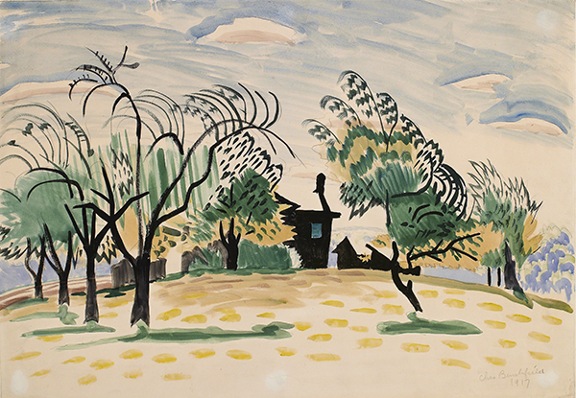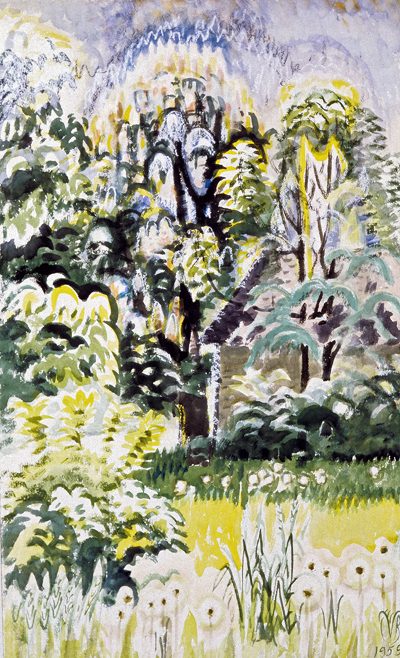Welcome to May! Charles Burchfield
To welcome the wonderful month of May, let’s look at the work of an extremely unique artist who sought not only to capture what he saw in nature, but also what he felt: Charles Burchfield. He is one of those artists whose connection with nature is intense, and his vision highly personal.
 |
| Charles Burchfield (1893–1967, U.S.), Windy May Morning, 1917. Watercolor on paper, 14" x 20" (35.6 x 50.8 cm). Courtesy of the Buffalo AKG Art Museum, Buffalo, NY. © 2024 Charles Burchfield Foundation. (AK-789) |
Throughout the history of American art, there have been artists whose vision is so personal that it cannot easily fit into a category. Examples would be David Gilmour Blythe (1815–1865), John Quidor (1801–1881), Ralph Albert Blakelock (1847–1919), and Albert Pinkham Ryder (1847–1917). While their vision was unusual, none of these artists ever truly strayed from the American naturalistic tradition. Burchfield, however, developed a personal style that conveyed sensations, natural forces, and symbolic associations.
Burchfield’s “sensation” landscapes are usually characterized by a somewhat restricted palette. Typically, Burchfield used lines of all sizes to indicate the nonvisual sensation he wished to express. In this early work, Windy May Morning, the bending lines of the trees indicate the direction of the wind referenced in the title. Such emphasis on line always included complementary movement in the brushstrokes of the sky and other elements of landscape.
The year Windy May Morning was painted, 1917, was Burchfield’s epiphany year. At this time, he developed a system of visual motifs that embodied moods and energies Burchfield called “conventions for abstract thoughts”—painted symbols for unseen forces. To manifest these forces, Burchfield used a variety of drawn lines whose placement indicate underlying forces.
Born in Ashtabula Harbor, Ohio, Burchfield studied art at the Cleveland Museum of Art, graduating in 1916. He subsequently worked for the manufacturer W. H. Mullins Company in Salem, Ohio, painting watercolors when he had time. From 1918 to 1919, he served in the U.S. Army painting camouflage. In the 1920s, Burchfield was a wallpaper designer for M. H. Birge & Sons in Buffalo, New York. Maybe as a reaction to his more industrial work experiences, Burchfield’s landscapes often take on a somber, almost menacing interpretation.
Up until the 1920s, Burchfield primarily painted landscapes. In 1919, he was greatly influenced by the book Winesburg, Ohio (1919) by Sherwood Anderson (1876–1941). Centered around a group of fictional characters, the book graphically depicts the barrenness of rural America based on the fictional main character who eventually leaves for the big city. In the 1930s and 1940s, Burchfield's work was primarily recognized as part of the American Scene phenomenon of the Great Depression (1929–1940).
During the Depression period, Burchfield’s American Scene Painting realism might be called social realist townscapes. By the mid-1940s, Burchfield had abandoned this style. While elements of objectivity remained in his landscapes, he was increasingly fascinated by representing his sensations and intangible elements of nature such as wind, insect sounds, smells, and heat radiating off of plants.
At this time, Burchfield returned to the mystical ideas of his works from the late 1910s. Although he felt these earlier works were unsuccessful, he used them as inspiration for new, monumental works late in life. Almost always painting in watercolor, Burchfield depicted the ephemeral forces that he felt surrounded and radiated from elements in nature.
 |
| Charles Burchfield, Landscape with Trees and Dandelions, 1959. Watercolor on paper, 54 ½" x 38" (138.4 x 96.5 cm). Courtesy of the Mint Museum of Art, Charlotte, NC. © 2024 Charles Burchfield Foundation. (MIN-17) |
In Landscape with Trees and Dandelions, Burchfield animated the bright summer sky with lines of force that may indicate the movement of the leaves or the sound of cicadas. Tree and flora are transformed into virtual lines of force to express form with strong contour line, grounding the composition as a landscape. The result is a shimmering radiance that expresses the artist’s lifelong love of the natural world.
Correlations to Davis programs: Explorations in Art 2E Grade 1: 4.5; Explorations in Art 2E Grade 3: 5.4; Explorations in Art 2E Grade 4: 4.5; Explorations in Art 2E Grade 5: 4.2; Explorations in Art 2E Grade 6: 2.2; Experience Art: 4.1; A Community Connection 2E: 5.1; A Global Pursuit 2E: 7.1; A Personal Journey 2E: 5.1, 5.4; Discovering Drawing 3E: p. 252


Comments